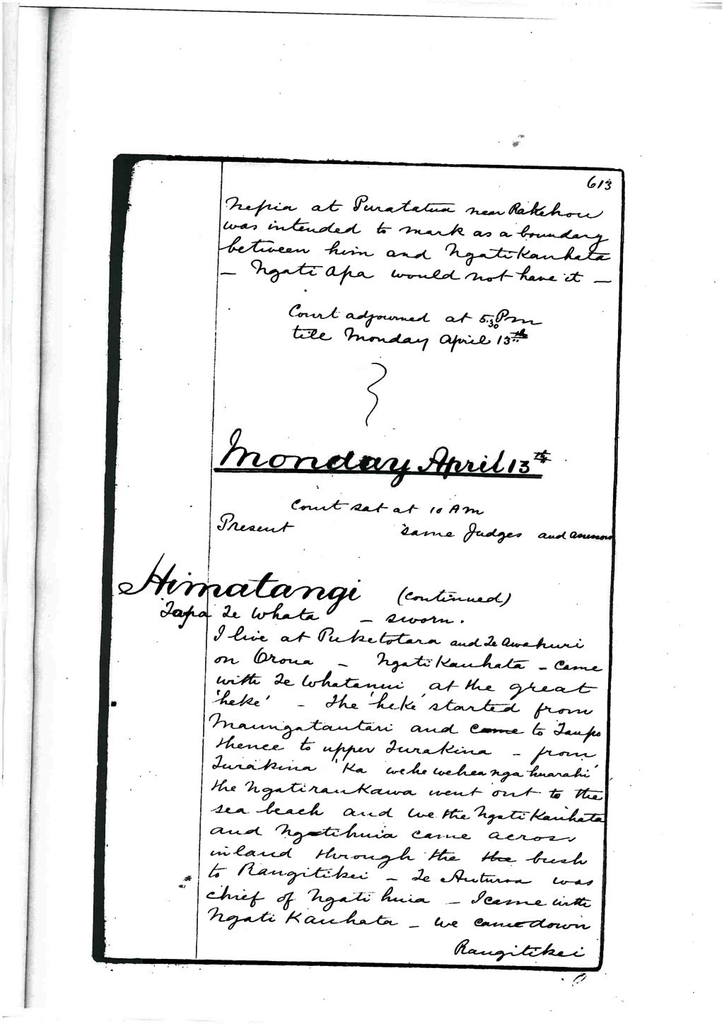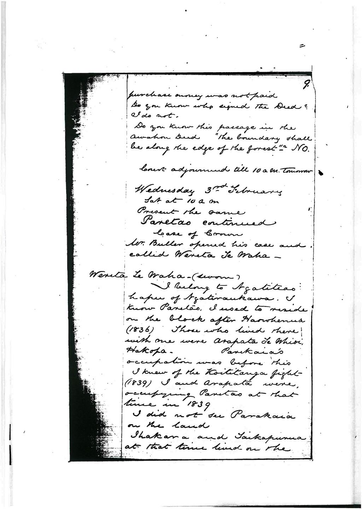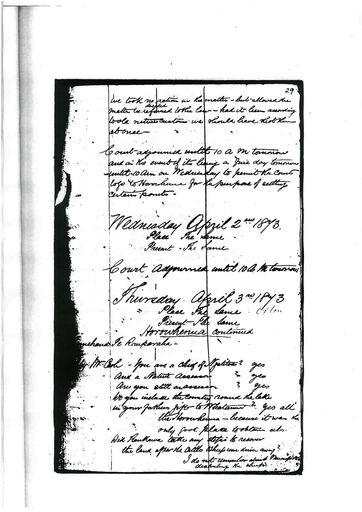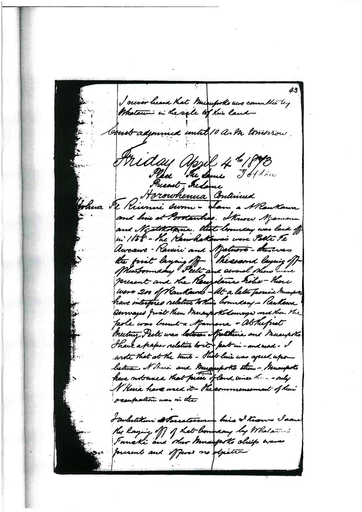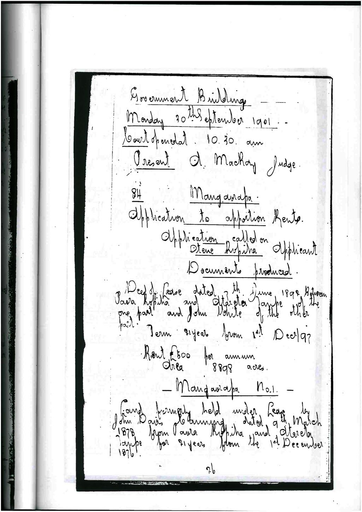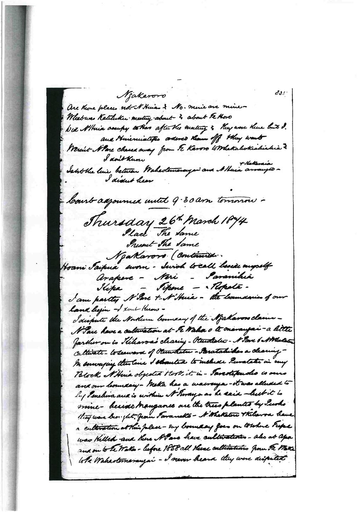13 April 1868
- Description
Monday April 13th
Court sat at 10 am.
Present – same judges and assessors.
Himatangi – continued
Tapa Te Whata – Sworn.
I live at Puketotara and Te Awahuri on Oroua. Ngati Kauhata. I came with Te Wahatanui, at the great ‘heke’. The ‘heke’ started from Maungatautari and came to Taupo, thence to upper Turakina. From Turakina ‘ka wehe wehea nga huarahi’. The Ngatiraukawa went out to the sea beach and we, the Ngati Kauhata and Ngatihuia came across inland through the bush to Rangitikei. Te Auturoa was chief of Ngatihuia. I came with Ngati Kauhata. We came down Rangitikei on the north side. Stayed at Paeroa – a Ngatiapa settlement, since called Parewanui. Stayed there and crossed the Rangitikei to south side to Poutu. There, my father wished to go inland to look for a ‘kainga’ for himself then we (a small party) went up the south bank of Rangitikei leaving the body at Poutu. Went to Waituna thence to Parewharariki, inland towards Oroua. At Parewharariki we found Ngatiapa. A man and woman took them. The woman told us that the man, her ‘tane’, was a ‘taungata kino he tangata makutu’ and that if he was spared we should all die. He was therefore killed. We went to Whakamo takapu and caught some Ngatiapa’s there. There was no fighting ‘he hopuhopu noa iho’. Went along the Kiuritea to Oroua. On reaching Oroua, went up the river to Te Ruapuha and Waioteha thence to Oturoriki where we took more Ngatiapa prisoners. Te Whata asked one of the women, (kete a chief), “who are the chiefs of this land?” She said “Te Hanea, Te Auahi and Te Raikokiritia”. Te Whata then said to all his party, “If we see these men, they shall be ‘hoa aroha’ of mine”. He searched for these men but did not find them. We then came down Oroua to Mangawhata. He, (Te Whata) said that should be his place. He came on to Manawatu. There we caught some Rangitane near Puketotara – these men were killed. It was not Te Whata’s thought to kill them. It was through the Ngatiapa who had been previously taken in consequence of old feuds between the Ngatiapa and Rangitane. We then went up Manawatu and surprised a Rangitane ‘kainga’ – Hakione, on the other side of Manawatu. Took them and killed one of them - the one who turned to defend himself. The others fled up the Manawatu and we let them go. We then came down Manawatu to the mouth, left our canoes and came on to Otaki and Waikanae. There were no people here. The people were all at Kapiti with the ‘heke’ of Whatanui and the party left by my father at Poutu. From Waikanae, crossed to Kapiti. At Kapiti, Rauparaha assembled the people at Rangatira – the house was ‘Te umu ki Ohau’. All Ngatiraukawa chiefs assembled. My father and Te Wharepakau Te Matuku (Ngatikauhata chiefs). Rauparaha addressed Ngatiraukawa and afterwards spoke to Te Whata “to kainga ko Waikawa and Waitohu and Waitaheke – (Waitaheke had however been given already to Te Wharepakau by Pokaitara and Pehi and Ngatitoa chief) also Porirua”. Te Whata replied “it is well, but you should tell Ngatiraukawa what they are to have – “Ko ahau, he kainga ano toku naku ano i kimi, ko Oroua te ingoa”. Rauparaha assented. After this, a party of Ngatiapa with Wi Mokomoko, some of Te Hanea (Hamuera’s brother) came to Kapiti. Came to fetch his mother, the woman of whom Te Whata asked about the chiefs (Kete). We went back to Oroua with Mokomoko’s party to Rotonui a hau. Found Ngatiapa there. They greeted us and Kete. Te Rai Kokiritia and Te Hanea and Te Auahi. Te Rai Kokiritia got up and said ‘he oi ano te kopaki mou, ko aorangi”. On the mountain side of Oroua, “and Whakaari”. All the chiefs confirmed this gift. Te Auahi took a canoe and stuck it up as a ‘pou’ and called it “Te Hokowhitu o Ngati Kauhata”. We accepted it. Ngatiapa had ‘mana’ at that time. They gave us this land. My father was friendly with Ngatiapa chiefs. This was before Haowhenua, the same year in which we came, we came, we joined in the Haowhenua, after putting in this ‘pou’. My father returned toKapiti, leaving some of Ngati Kauhata at Oroua. Hori Te Nuku my ‘tuakana’ was one and his ‘teina’ Hemokanga was another and Hairuha Huanga and Toroa Hunganui – these remained behind. Went up to cultivate with Ngatiapa. After planting, they came down to Otaki which was then occupied. Stayed here and returned (a large party) to Oroua to take eels at Te Pekarakau – returned to Otaki. It was after this that Haowhenua took place. There were no other ‘hapu’s noho tuturu’ on the land between Manawatu and Rangitikei rivers. Saw parties going to catch eels. Ngatiapa and Rangitane fires were burning all over the district between the two rivers, up to the time of Himatangi. The place I know of a dispute among Ngatiraukawas about Te Whakapuni on the other side of Manawatu before Haowhenua. The ‘pas’ of Ngatiapa occupied at the time of Te Kuititanga at Oroua, were, Te Putanga (Ngatiapa), it was fenced but not fortified. Half a ‘kainga’ and half a ‘pa’. Rakautatahi (Ngatiapa) a ‘pa’, Karangatiko (Ngatiapa) ‘pa’, Hinau – a – hapainga (Ngatiapa and Rangitane) ‘pa’, Tawhiri – a – te – uri – ki (Ngatiapa and sometimes Rangitane) – a large ‘kainga’, Keri tako (Ngatiapa and Rangitane) a large ‘kainga’, Kahukore (Ngatiapa) ‘he kainga nui’, Tamatehi (Ngatiapa and Rangitane) a strong ‘pa’. These ‘pas’ belonged to Ngatiapa and Rangitane. Ngatiapa and Rangitane were always catching eels. There are a great many eel ponds in the Rangitikei Manawatu block. I know Kai ko kopu. It is a large sheet of water about a mile long, of varying width. I know Himatangi. It is a sand hill and manuka bush. The Himatangi cultivations are in the ‘nga here here’ adjoining. Matene Te Matuku and Pakura were cultivating at the time of Haowhenua. I heard that these cultivations were theirs. I saw the potatoes. I did not see the cultivating at the time of the Kuititanga but I saw the old man, Pakura, come to catch birds at Herangi, the year of Te Kuititanga. I did not see cultivating potatoes.
I remember the Patukohuru and NRakau ‘hapu’s’ going up Manawatu. It was immediately after Haowhenua. They went first to Awahou then to Puketotara then up Oroua – ‘ki te kimi kai’ Went to Waikanae and eat the food they found there belonging to Rangitane and to us and then to Te Tioriroa and eat the food there belonging to same. Went on to Te Hauri near Te Putanga, eat food (Ngatiapa’s food). Went to Taingaroawhetu and did the same. (Ngatiapa and mine) searched for the ‘rua taewa’. On to Takatu (Ngatiapa and I) and took potatoes, eating and carrying away. Returned from Takatu having seemed a large supply of potatoes. Came to Puketotara and stayed there a short time. They then went to Te Kiri Kiri on this side of Manawatu then they made clearings there where they planted the seed obtained on the Oroua. Staid a long time there and occupied. Also Tapuaerau, also on south side of Manawatu below Te Kiri Kiri extended lower to Opiki and Ngatirakau. Staid there, occupying the land between Te Kiri Kiri to Opiki. After occupying Opiki, floods two or 3 years and they crossed and built Te a Ahimate on north side (high land). Continued to cultivate at Opiki while the ‘pa’ was on north side. The only two places on the north side of Manawatu. I know that was occupied by them before Kuititanga, were Ahimate and Moutoa. Papakiri was not occupied as far as I saw. I did not know of Papakiri at that time. Papakiri was first occupied long after. It was occupied a short time before the sale of Te Awahou block – (about Utahi whom Ihakara thought lived at Papakiri). Utahi came from Taupo. I don’t know when he came to Manawatu but I first saw him at Ake ake living there. My child was able to walk when I saw Utahi at Ake ake. He (my son) was born in 1845. Went across to the place since called Papakiri about a year before Te Awahou sale – (Parakaia’s ‘hapu’s’). I don’t know about the subdivision of these tribes. I know only the Ngati Rakau. I should, if asked the name of the tribes occupying the banks of Manawatu, say Ngati Rakau. I used to go often to Moutoa. I have been frequently at Papakiri since its settlement. The men and women of Ngati Rakau, I do not know the number, 100 or not. At the time of the ‘kuititanga’, they were not a very numerous ‘hapu’. I only know of Ihakara’s ‘tupapako’ at Whitirea. I know Paratene. I knew him as a Ngati Rakau. He is also a Patu Kohuru. Ihakara and Patu Kohuru and Ngati Rakau had cultivations at Himatangi. At the same time as Te Kiri Kiri was being cultivated. Papawharangi was the name of the cultivation. Ngawhare cultivated - he is of Patukohuru. There may have been others but I know him. When he had done cultivating, he went up to Hinau – o – hapainga, with his wife. After Ihakara left Papawharangi, Paratene Taupiri continued to cultivate on the river bank near Whitirea.
I remember the fixing of Whitirea boundary – later fixing. Before that it was mere talk. I refer to the taking on the boundary to the sea. I took part in the arrangement of boundary. It was when the sale of Te Awahou was being talked about. It was laid down as a boundary of my land. The land on the south was to be for Nepia and Ngatiapa. The ‘rohe’ was a ‘rohe pupuri whenua’. I was against selling at that time. After the sale of the Awahou, both ‘rohe’s remained ‘i tu tonu’. I understood the land on the south of the Whitirea Paepae was for Nepia and Ngatiapa. I did not know anything of a boundary from Omarupapako to Paepae at the time of the arranging of the Whitirea boundary. I know the north boundary of Awahou block. That was an old boundary fixed by Hakeke, Te Hanea and Matene’s ‘pous’ but it was altered from Moutoa. Pakingahau is the new post. It was taken there from Moutoa.
Court adjourned at 1.30 pm for 1 hour.
Court resumed at 2.30 pm.
Mr. Fox – stated that he wished to apply to the court for an order to allow the actual and extinct cultivations in the Himatangi block to be surveyed, stating that an attempt had been made to survey these cultivations and the surveyor had been interrupted and sent off the ground.
The court hesitated about making the order on the ground that it did not appear to the court that evidence on this point was material.
After some discussion, it was arranged that a letter should be written by the agent for the native claimants and by Parakaia to the residents requesting them to allow the survey to proceed.
Tapa Te Whata – recalled
Tesed by Mr. Williams.
Te Rauparaha sent for us to come here. We came as ‘rangatira’ to Kapiti ‘ki te wahi pu’. When we arrived, found that Ngatiapa and Muaupoko and Rangitane had been ‘patu’ by Rauparaha. It was partly Rauparaha assenting that we occupied Oroua but my father said that he had found a place. When we came here they had no ‘pa’. They were occupying their kainga’s, Urere, on the bank of the Oroua. We caught some and those we did not catch ran away into the bush. I don’t know about Ngatiapa having no ‘maua’. They were living in fear. I heard of the coming of Ngatiwhakatere and Ngatitoa. I did not hear formerly that they came separately from Ngatitoa. I have heard lately that they came at different times. When I came, I found that all the ‘pa’s’ of Ngatiapa had been taken by Ngatitoa, Ngapuhi, Ngatiwhakatere and Ngati Tama. We divided the land. I told the word of Te Whata about the chiefs. In coming down, Te Whata said the land should be for Ngati Kauhata. Caught Ngatiapa’s and took land, by word only at first. There are several branches of Ngati Kauhata – Ngati Te Ihi ihi, Ngati Hinepare, Ngati Kura and many others and the great name is Ngati Kauhata and Ngati Rakau is the name which includes Parakaia’s ‘hapu’s’ – Ngatituranga and Ngati te au. Te Whata is my father, is chief of Ngati Kauhata. Tahora is a young chief, a ‘toa’. Tohutohu is a chief, Te Whetu, these are ‘toa’s’. They are also chiefs. Te Kiuri Mokowhiti was the chief of Ngati Te Ihi ihi. Te Whata was the ‘rangatira o te iwi’. Tahora is father of Te Aratakaua. Te Whata’s nephews are alive. Ngatiapa were living at Oroua. The only one of Ngatiapa of whom I know as killed was the ‘makutu’ man I spoke of. There may have been others killed. I did not hear. Some of Rangitane were killed. The reason why Ngatiapa were not killed was because we did not wish to kill. We did not come to kill. Another reason was we heard that Rauparaha was not at enmity and that ‘kua pakuhatia tena whenua i a mokau. (Rangihaeata) heard of this on the return of the ‘heke’s’ “whirinui” and “Kariri”. Before the great ‘heke’, we did not ask if those we caught were Ngatiapa or Rangitane and killed or saved but the Rangitane were killed at the instigation of Ngatiapa. There was a feud between Ngatiapa and Rangitane at the time. I don’t know whether Whatnui’s party killed Ngatiapa at Turakina. I did not hear that Whatanui killed Ngatiapa at Turakina. There may be another who did hear. The Ngatiapa’s caught at Oroua were brought here as slaves (Mokai). I can’t explain about the Ngatiapa slaves being brought here after knowing Rauparaha sentiments but I know of the word of enquiry about the Ngatiapa chiefs who were not found when my father came – (asked for to be ‘hoa aroha’). Those of Ngatiapa who were not caught ran away into the bush. I did not hear of Te Whariki at Turakina. My father may have heard or others but it was not told to me. TheNgatiapa ‘mana’ was with those who remained behind in the places where they ran to.
I remember the sale of Te Ahu – o – turanga. I know the boundary on the Oroua side. It was fixed by me (Ngati Kauhata) and a Ngatiapa man – (Hamuera). It was fixed as a boundary for Rangitane and Te Huriawanu for their work of selling. Ngati Kauhata and Hamuera Te Raokokiritia gave Rangitane some land at that time. Ngatiapa were interested in the land then. They and I were ‘hoa aroha’. There was a dispute. Rangitane wanted to have the Oroua as a boundary of the sale but we disapproved and took it back. We said we would keep this side when they wished to have Oroua as the boundary but the boundary was not fixed there. The land between the Ahu – o – turanga and Oroua belongs to us (Ngat Kauhata and Hamuera) – not all Ngatiapa but Hamuera. Ngatiapa all claim but I admit only Hamuera. Hamuera’s portion is that at the upper end. He has none below. His claim is above Mangawhara. He has no land below. This is part of Aorangi, a part of which has been included in the Ahu – o – turanga. We own the land. We therefore arranged the boundary of that block. I admit Hamuera’s claim. I don’t know if all Ngati Kauhata do. Rangitane claim the lower portion of the strip. Kerei and another (Tutere) have claims in the upper portion. Tutere and Rota and Tuhuiapo, they and I have cultivations but the bulk of Rangitane have their land at Manawatu. Within the Ahu – o –turanga block and down to the Oroua, on both sides of the river, most of the cultivations are in the Ahu – o – turanga block but there are others on the Manawatu below down to Oroua. I heard that the whole of Rangitane have claims in the land sold to the crown – claim through ancestors. The Ngatiapa ‘pa’s’ on Oroua were built after Haowhenua. They were abandoned, one formerly, one after introduction of Christianity. 2 still occupied up to the present time. Ngatiapa were living in numbers. I don’t know how many. At the kuititanga, some of them were abandoned and some were not. Te Putanga continued to be occupied. After, a great many died there and lately some of them have gone to Rangitikei.
Further hearing adjourned till tomorrow.
Court adjourned at 5.30 pm.
Court sat at 8 pm.
Present – T. H. Smith, N. B. White and same assessors.
Tutangatakino No. 3 – Tiemi Rauapiri
Tiemi Rauapiri appeared.
Land surveyed by Mr. Hughes.
John Hughes – Land surveyor – Sworn.
Produced plan. Evidence as to survey and plan. Employed by claimant. Boundaries pointed out by him. Boundaries marked on ground and rules of court observed. No interruption of survey. I am not aware of any dispute as to ownership. The land on the south is in the occupation of Dr. Hewson and there is a fence dividing his land from this claim. Land on the other side is native land.
Tiemi Rauapiri – Sworn.
Identified land on plan. Live at Otaki of NgatiRaukawa – a half caste. This land belonged to the ‘tungane’ and ‘matua’ of my mother Erena Rangiwhakairi. The land was given to her. It was hers only during her lifetime. She has been dead 3 years. She left it to me only. There are other children. I am the eldest son. There are 3 younger sons. There are 2 sisters. Mere is my elder sister. ‘Kua moe tane’. Haua is also a sister of mine (‘also moe tane’) – older than myself and younger than Mere. We have other lands. I have sold this land. My brothers and sisters all agreed to the sale. They all shared in the payment which I received. I apply for a certificate that I may have a grant and execute a conveyance. I sold the land to Dr. Hewson and ‘Takuta’ in my application is meant for Dr. Hewson.
Objectors challenged.
Karanama Te Whakaheke appeared as counter claimant. Sworn.
Live at Pukekaraka of Ngatiraukawa. I know the land shown in the plan. The survey includes land belonging to me. I apply for a certificate for my portion. I have not surveyed my claim. I claim a strip running along the whole length of Dr. Hewson’s fence. My father, Te Whakaheke, cleared that land. It was shortly after Haowhenua. We (the Mateawa) lived here at a ‘kainga’ called Tutangatakino, at the west end of the strip of land claimed by Tiemi. I cultivated the strip of land. The doctor’s fence is on an old boundary. The south side belonged to Paranapa of Te Mateawa and on the north side, the land belonged to me and the next beyond belonged to Marino Whakareke who was a ‘papa’ of Erena’s mother. I cultivated it for many years. I was cultivating there, the year Archdeacon Hadfield came and for some years afterwards. This is my claim to the land. Hipirini has seen me cultivating this land.
After my leaving this land, Marino and Erena cultivated the land. Meri Hiana, was the wife of Marino, was sister to my mother. Karewahuia was my mother. Meri Hiana and Marino and Erena (Tiemi’s mother) cultivated after I left. I went to Waikato after I cleared to cultivate. I was 8 years absent. I came back the year that Rangiatea was finished. On my return, no one was occupying it. I have not occupied it since. I did not cultivate together with Marino. I had my separate piece.
Tesed by Tiemi.
I know that the fence of Dr. Hewson’s is on the boundary of my land and Paranapa because Paranapa would not ‘pokonoa’ to sell my land. I know that the boundary of the piece sold is my boundary because it is the boundary of the piece sold. When he cultivated that boundary, it was marked with ‘tawa’ and other ‘pou’. That was all. I did not know of your mother selling a strip of land east of the present fence. When I heard of your sale to the doctor, I did not come to you because when I heard of it, the money was gone. I heard of it in the summer of last year. The year that Rangitikei block was paid for. I spoke to him at Pukekaraka, a month before last planting season, about August 1867. I ‘whakahe’d’ him because he gave me none of the money. If he had given me some of the money, I should not have ‘whakahe’d’ him. He gave some to Marino.
Further hearing postponed.
(Continued at pp 635 in this book)
Court adjourned at 10 pm till tomorrow.
Identification
Taxonomy
- Community Tags


